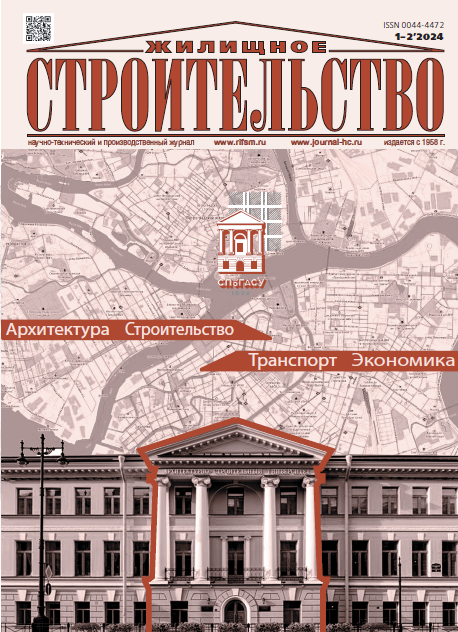History and Prospects of Development of Low-Rise Wooden Buildings in Cities of the North of Russia
- Autores: Perov F.V.1, Mangushev R.A.1, Dacjuk T.A.1, Bolotin S.A.1
-
Afiliações:
- Saint-Petersburg State University of Architecture and Civil Engineering
- Edição: Nº 1-2 (2024)
- Páginas: 51-57
- Seção: Articles
- URL: https://innoscience.ru/0044-4472/article/view/635833
- DOI: https://doi.org/10.31659/0044-4472-2024-1-2-51-57
- ID: 635833
Citar
Texto integral
Resumo
Low-rise timber buildings are an important part of Arctic cities. This is due to a number of factors: the traditions of using wood in construction, accessibility and simplicity, mastery of the technology of processing wood as a building material, the ability to quickly construct buildings from ready-made elements, high thermal qualities of wood. The modern emergency low-rise wooden building fund has discredited itself, which has led to an increase in the construction of capital multi-apartment buildings using technologies from cities in central Russia. Currently, economics, ecology, and the development of modern technologies dictate the need to revive low-rise wooden residential buildings at a new qualitative level, including the development of a new typology of residential buildings that meet the diverse modern requirements of the population of Arctic cities.
Texto integral
Sobre autores
F. Perov
Saint-Petersburg State University of Architecture and Civil Engineering
Autor responsável pela correspondência
Email: f.perov@gmail.com
Candidate of Architecture, Docent
Rússia, 4, 2nd Krasnoarmeyskaya Street, Saint Petersburg 190005R. Mangushev
Saint-Petersburg State University of Architecture and Civil Engineering
Email: mangushev.r.a@lan.spbgasu.ru
Doctor of Sciences (Engineering), Professor
Rússia, 4, 2nd Krasnoarmeyskaya Street, Saint Petersburg 190005T. Dacjuk
Saint-Petersburg State University of Architecture and Civil Engineering
Email: dacjuk.t.a@lan.spbgasu.ru
Doctor of Sciences(Engineering), Professor
Rússia, 4, 2nd Krasnoarmeyskaya Street, Saint Petersburg 190005S. Bolotin
Saint-Petersburg State University of Architecture and Civil Engineering
Email: bolotin.s.a@lan.spbgasu.ru
Doctor of Sciences (Engineering), Professor
Rússia, 4, 2nd Krasnoarmeyskaya Street, Saint Petersburg 190005Bibliografia
- Perov F.V., Lobanov Y.N. Vorkuta. Architectural heritage of the Soviet cities of the Arctic. Perspektivy nauki. 2022. No. 3 (150), pp. 317–321. (In Russian).
- Detter G.F., Levkina A.O. Arctic cities of Russia on the way to smart sustainability. Arktika. Ekologiya i ekonomika. 2023. Vol. 13. No. 2, pp. 180–187. (In Russian). DOI: https://doi.org/10.25283/2223-4594-2023-3
- Sоlogub L.P., Cherkasova I.Y. Domestic historical experience of the construction of mobile buildings in hard-to-reach areas. Nauchnuy vestnik of the Voronezh State University of Architecture and Civil Engineering. Series: High technology. Ecology. 2016. No. 1, pp. 93–95. (In Russian).
- Ivashkina I.V., Li M.Y. Climate challenges: the best world practices of successful cities. Arhitektura i stroitel’stvo Rossii. 2023. No. 2. (In Russian).
- Eremeeva A.F. Features of the tourist infrastructure in the Russian Arctic. Problems and development potential. Sistemnye tekhnologii. 2022. No. 2 (43), pp. 68–74. (In Russian). DOI: https://doi.org/10.55287/22275398-2022-2-686
- Perov F.V. Architecture of cryptoclimatic complexes for Arctic cities. Sistemnye tekhnologii. 2022. No. 3 (44), pp. 153–160. (In Russian). DOI: https://doi.org/10.55287/22275398_3_153
- Blagodeteleva O.M. Cryptoclimatic building. Arhitektura i stroitel’stvo Rossii. 2016. No. 4 (220), pp. 111–112. (In Russian). DOI: https://doi.org/10.55394-2016-4-111
- Poddaeva O. Modeling of Snow Loads on Roofs of Unique Buildings. Arhitektura i inzheneriya. 2023. Vol. 8. No. 3, pp. 53–59. (In Russian).
- Sokolov N.S., Sokolov S.N., Sokolov A.N. Fine-grained concrete as a structural building material of drilling piles ERT. Stroitel’nye Materialy [Construction Materials]. 2017. No. 5, pp. 16–19. (In Russian).
- Kamenev I.V. Verification of the mathematical model of the deformed state of cylindrical SLT panels. Vestnik grazhdanskih inzhenerov. 2023. No. 3 (98), pp. 25–32. (In Russian). DOI: https://doi.org/10.23968/1999-5571-2023-20-3-25-32
Arquivos suplementares



















